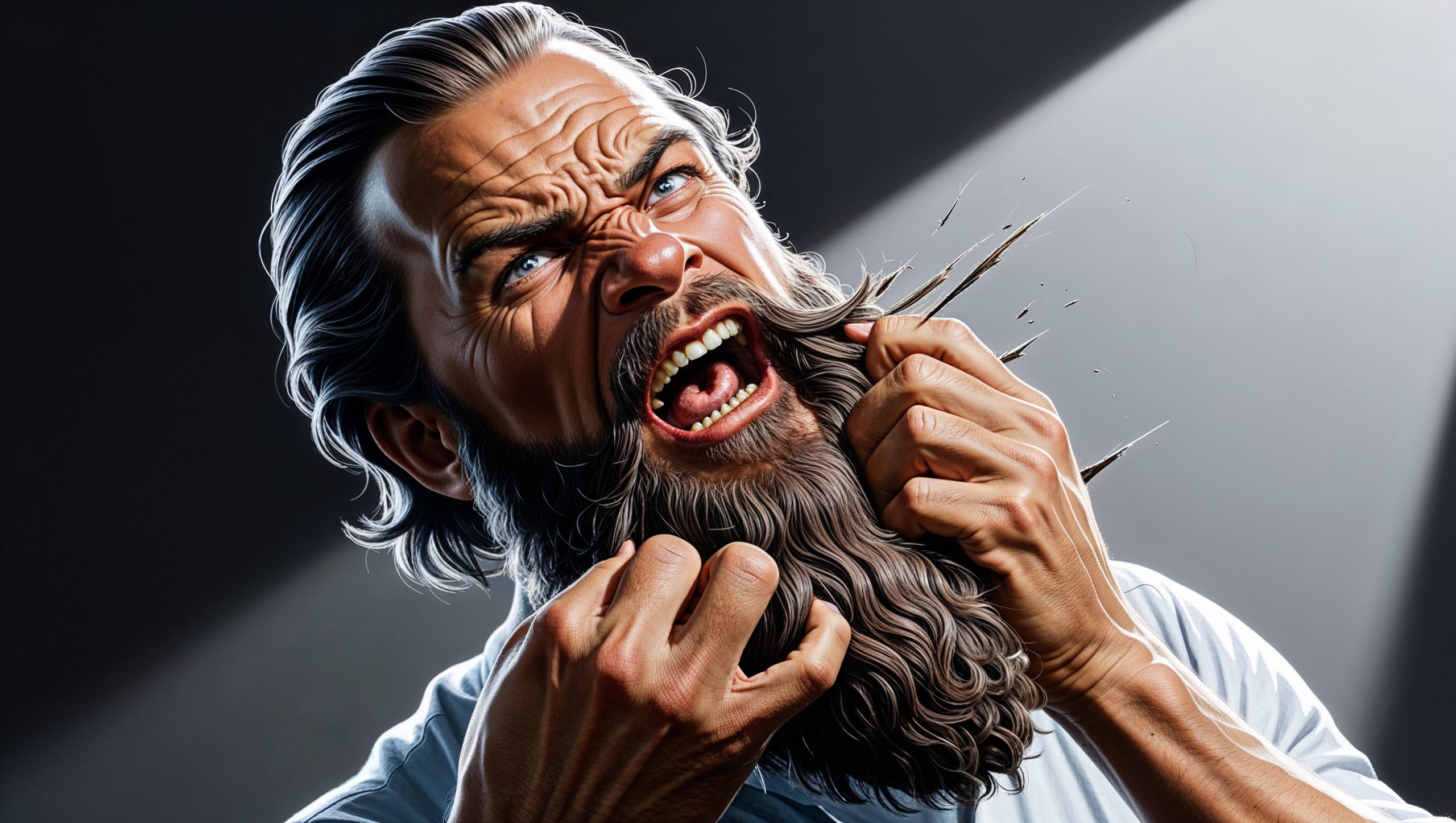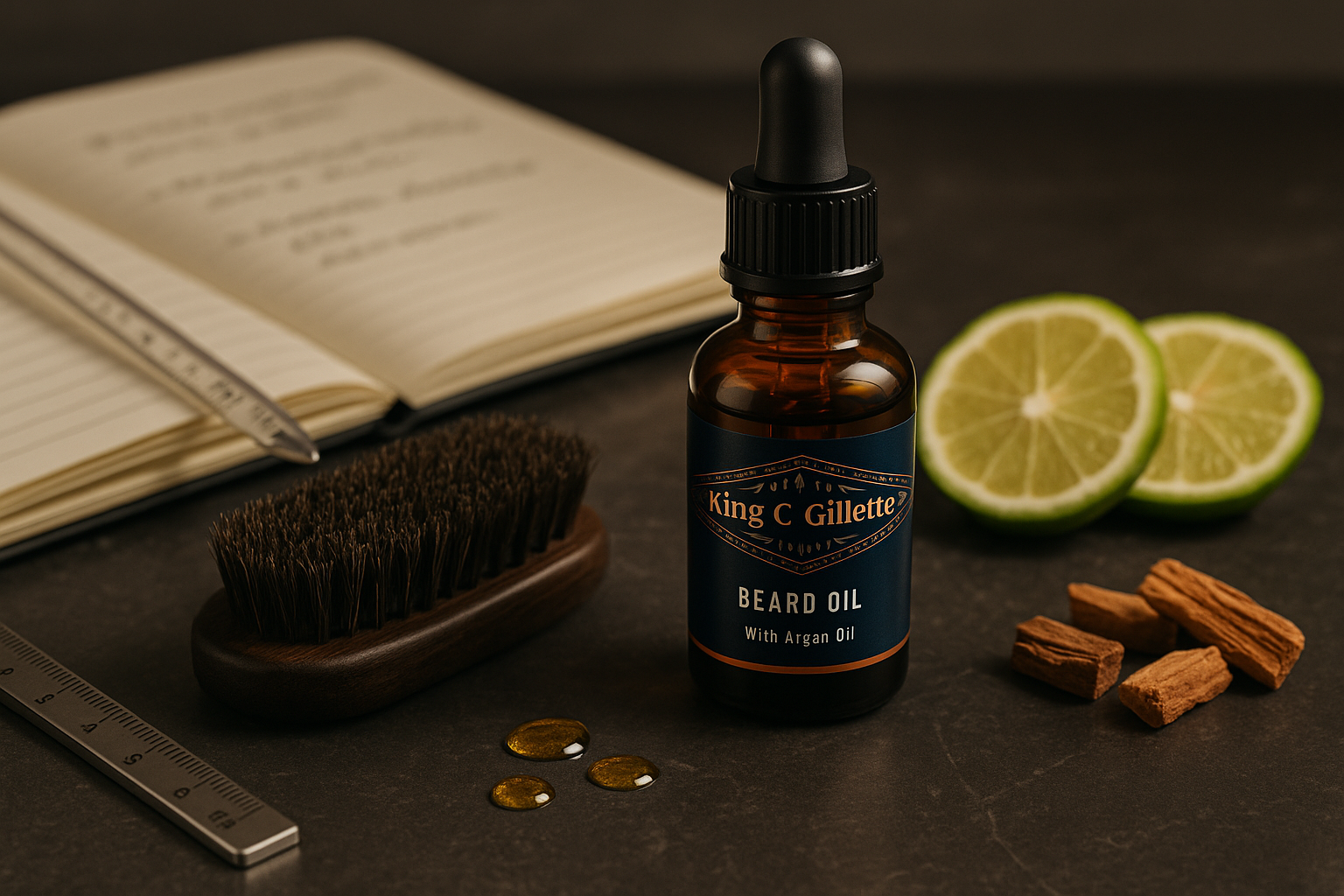The Patchwork Challenge and How to Fix a Patchy Beard

If you’ve ever looked in the mirror during the first few weeks of growth and seen what looks less like a rugged statement and more like a collection of disconnected islands, you’re not alone. The patchy beard—that frustrating, uneven sprawl of facial hair—is one of the top reasons men across the USA and Canada abandon their beard goals. It can feel like a personal failure, but we’re here to tell you: it’s not a failure of will; it’s a perfectly normal biological reality.
For decades, the standard advice has been “just wait it out.” While patience is a virtue, it’s not the whole solution. This definitive guide moves past the clichés, diving deep into the science of hair growth, the impact of genetics, and the advanced, tactical grooming strategies you need.
This article provides the complete playbook on how to fix a patchy beard. We’ll cover everything from maximizing your natural growth potential to surgical options, ensuring you have the knowledge to turn that frustrating patchwork into a confident, uniform look.
Section 1: Decoding the Patchiness – The Science of Uneven Growth
Before you can learn how to fix a patchy beard, you must understand why the patches exist. The answer lies deep within your genetics and your hair’s unique life cycle.
Understanding the Role of Genetics and Density
The primary driver of beard density and pattern is genetics, specifically the distribution of androgen receptors on your face.
- Androgen Receptors: These are the tiny docking sites on your hair follicles that respond to testosterone and, more powerfully, dihydrotestosterone (DHT). The more receptors a follicle has, the thicker and longer the hair it produces will be. If certain areas of your face—like the cheeks, connecting lines, or under the jaw—naturally have fewer of these receptors, those spots will produce finer, sparser hair, leading to patchiness.
- The Primary Driver: This is why one man can grow a full, thick beard in a month, while another takes six months to achieve the same coverage. It’s not a matter of trying harder; it’s a matter of biological predisposition.
Setting Realistic Expectations: While you can significantly improve the appearance of your beard, if a spot has no follicles (due to scarring, for example), or if the follicles have very few androgen receptors, you may need to accept that a fully dense, thick covering might not be achievable in that specific spot. The goal is to maximize the growth you do have and use grooming to create the illusion of uniformity.
The Hair Growth Cycle and Timing Your Patience
The hair on your face grows in three distinct phases, and understanding them is crucial to knowing how to fix a patchy beard with time.
- Anagen (The Growth Phase): This is the active stage where the hair is physically growing from the follicle. On the scalp, this phase can last years. On the face, it’s typically shorter. The key to fixing a patchy beard is allowing the hair in the anagen phase to grow long enough to cover surrounding patches.
- Catagen (The Transition Phase): A brief stage where the follicle shrinks and hair growth stops.
- Telogen (The Resting Phase): The hair is completely dormant and eventually sheds.
The 1−3 Month Rule: Most men bail out on their beard journey between 3 and 6 weeks, which is precisely when patchiness is at its most visible. You must push past this stage. The surrounding, longer hairs often take 2-3 months to develop enough length and weight to naturally droop or sweep over the sparser spots. Patience is the foundation of any patchy beard solution.
Common Medical and Physiological Reasons for Patches
While genetics account for most patchiness, specific conditions can cause sudden or noticeable loss, requiring medical attention:
- Alopecia Areata Barbae: This is an autoimmune condition where the body mistakenly attacks the hair follicles, leading to distinct, often perfectly circular, smooth, bald patches in the beard. This requires a consultation with a dermatologist, who may prescribe topical steroids or other treatments. You cannot fix this type of patchy beard with oil or a comb.
- Stress and Telogen Effluvium: High, sustained stress can prematurely shock many hairs into the resting (Telogen) phase, causing temporary, noticeable shedding or thinning across the face. This thinning typically resolves once the stress factor is addressed.
- Folliculitis and Scars: Patches can be the result of scarring from past severe acne, injuries, or chronic bacterial infections (folliculitis) that permanently damaged the follicle.
Section 2: Foundational Strategies on “How to Fix a Patchy Beard”
This section outlines the essential, daily steps you can take to maximize the growth potential of every single hair follicle on your face. You can’t change your genes, but you can give your body the best fuel to work with.
Maximizing Natural Growth (The Internal Fix)

A fuller beard starts from the inside out. Your body prioritizes vital organs and functions over hair growth; if you’re deficient in key nutrients, hair quality and quantity will suffer.
The Nutritional Checklist for a Fuller Beard
- Biotin (Vitamin B7): Critical for the production of keratin, the structural protein of hair. While supplementing may not drastically change your patchy pattern, it ensures the hair you do grow is strong and less prone to breakage.
- Best Sources: Eggs, nuts (almonds, walnuts), whole grains, salmon.
- Zinc: Essential for hair tissue growth and repair. It also helps keep the oil glands around the follicle working correctly. Deficiency is strongly linked to hair loss.
- Best Sources: Red meat, seafood (oysters), lentils, pumpkin seeds.
- Vitamin D: Helps stimulate both old and new hair follicles. Ensuring you have healthy Vitamin D levels is foundational to overall skin and hair health.
- Best Sources: Sun exposure, fatty fish, fortified milk.
- Healthy Fats (Omega-3s): These are the building blocks of healthy cell membranes, including those in the hair follicle. They reduce inflammation, which can otherwise impede growth.
- Best Sources: Flaxseed, chia seeds, fatty fish (mackerel, salmon).
Sleep, Exercise, and Hormonal Optimization
The male hormones, particularly Testosterone and DHT, are the fuel for your beard. Maintaining healthy levels is a foundational step in how to fix a patchy beard.
- Weight Training: Resistance exercise is proven to naturally and temporarily boost testosterone levels.
- High-Quality Sleep: The majority of growth hormone release (which aids in cell repair and regeneration) occurs during deep sleep. Aim for 7−9 hours of restorative sleep nightly.
- Stress Management: As noted, chronic stress increases cortisol, which can impair hair growth. Incorporate mindfulness or vigorous exercise to manage stress levels.
The Power of Targeted Grooming and Stimulation

Focus on stimulating blood flow and ensuring your hair is healthy enough to achieve the maximum length needed to cover patches.
Exfoliation and Massage for Follicle Health
A dirty or neglected patch of skin often has clogged pores, dead skin cells, or impacted follicles, all of which inhibit a hair from emerging.
- The Technique: Use a boar’s hair beard brush daily. Brushing stimulates the skin, increases blood circulation to the area (bringing more nutrients to the follicles), and helps lift and train the existing hairs to lie down over patchy areas.
- Washing Correctly: Use a beard wash (not harsh hair shampoo) 2−3 times per week. Vigorously massage the wash down to the skin to ensure you are clearing out dead skin and sebum plugs that could be stifling growth.
The Derma Roller Technique: A Calculated Risk
For men determined to figure out how to fix a patchy beard by kick-starting dormant areas, the derma roller (or micro-needling) has gained popularity.
- The Mechanism: The roller uses hundreds of tiny needles (usually 0.25mm to 0.5mm) to create microscopic wounds in the skin. This triggers the skin’s natural healing response, which involves increased collagen production and better blood circulation. This influx of healing factors and nutrients is believed to potentially wake up dormant or underperforming follicles.
- Caution and Sanitation: Only use a dedicated derma roller designed for this purpose. Sanitize it thoroughly with 70% isopropyl alcohol before and after every single use to prevent infection. Use gentle pressure and limit use to 1−2 times per week.
Section 3: Advanced Tactical Grooming to Conceal Patchiness

Once you’ve addressed the internal factors, the next step is mastering the external illusion. This is where strategic grooming and patient styling provide the fastest answer to how to fix a patchy beard.
The Art of the 2–4 Month Grow-Out Strategy
This is the most critical, non-medical step for most men: Don’t trim the patches.
- The Principle: Longer hair has weight. By allowing the hair surrounding the patchy area to grow long, it will naturally lay down and fan out, effectively covering the thinner spots beneath. If you constantly trim the whole beard, you are removing the very length needed for coverage.
- The 4-Month Milestone: Commit to four full months of growth before making any significant shaping decisions. This gives even the slowest-growing hairs a chance to emerge and contributes maximum length to your coverage strategy.
Using the Cheek Line and Neckline to Your Advantage
While you want all the length you can get, clean edges create a powerful contrast that makes the entire beard appear thicker and more intentional.
- The Neckline: Shave a clean, sharp neckline roughly one to one-and-a-half inches above your Adam’s apple. A clean neck removes the scruff that visually drags the beard down and makes the hair above the line look denser.
- The Cheek Line: For patchy cheeks, let the top line grow natural. Don’t shave it down or trim it sharply. Allow the straggler hairs high on the cheek to add subtle density, which helps blend the thinner spots into your cheekbone structure.
Techniques for Blending and Filling Patches
Once you have 2+ months of length, you can employ tools designed to create uniformity.
Precision Trimming and Blending
When you finally do trim, use a clipper guard slightly longer than you initially planned.
- The Goal is Blending: Use the longest length setting that covers your thinnest patch. Then, taper slightly shorter hair (a half-guard difference) onto the areas that are already thick. This creates a uniform surface without sacrificing the length needed for coverage.
- Use a Comb: When trimming, constantly comb the hair upwards and outwards against the grain. This forces all the hairs to stand up straight, revealing the true length and any stray hairs that need to be removed to even the surface.
Beard Coloring and Cosmetic Fillers
For immediate, high-impact solutions to how to fix a patchy beard, especially in photos or formal settings, cosmetic aids are highly effective.
- Beard Dyes: If your beard is patchy because the new hairs are lighter, gray, or clear (known as vellus hair), simply coloring the hair can add incredible visual density. A darker hair shaft absorbs light better and creates the visual bulk that hides the underlying patchiness. Use beard-specific dyes, as they are gentler than standard hair dyes.
- Beard Fillers and Powders: These specialized products (often fiber-based or in the form of pencils and pomades) allow you to lightly fill in the skin beneath the sparser hair. They cling to the existing hair and skin, instantly making the area look denser and more uniform.
The Power of the Right Hairstyle Pairing

Your hairstyle frames your beard and can dramatically influence how the density is perceived.
- The Fade/Taper: A sharp fade or taper on the sides of your head creates a strong contrast with your cheek line. When the head hair goes from skin-level to full length, the visual density of your beard, even if patchy, appears much greater by comparison.
- Balance: If your beard is thin, grow your head hair a bit longer on top and style it back to add height and draw the eye upwards, away from the minor imperfections of your beard.
Section 4: Clinical Options for Permanent Solutions
For men whose patchy growth is resistant to time, nutrition, and tactical grooming, there are highly effective medical interventions that provide a more permanent answer to how to fix a patchy beard.
Topical Solutions: Minoxidil for Beard Growth
Minoxidil (5%, commonly known as Rogaine) is an over-the-counter topical solution primarily used for male pattern baldness, but it has gained significant popularity for off-label beard growth.
- The Mechanism: Minoxidil is a vasodilator, meaning it widens the blood vessels. When applied topically, it is believed to increase blood flow and nutrient delivery to the hair follicles and, crucially, to prolong the anagen (growth) phase. This effectively “holds” the hair in the growth stage for longer, allowing it to become thicker and longer, eventually filling out patchy areas.
- Safety and Commitment: Minoxidil is generally safe, but common side effects can include localized dry skin or slight irritation. The most important factor is commitment. You must use it consistently, usually twice daily, and results can take 4-12 months to fully appear. Once you stop, the hair growth achieved with Minoxidil may eventually reverse.
- How to Use for Patches: Apply directly to the skin in the patchy area and surrounding skin to maximize its effect on dormant follicles.

Hair Transplant Surgery (Follicular Unit Extraction – FUE)
For men who have achieved their maximum natural growth and still have noticeable, unacceptable patches, surgical intervention is the ultimate, permanent answer to how to fix a patchy beard.
Understanding the FUE Transplant Process
The most common technique is Follicular Unit Extraction (FUE):
- Harvesting: Individual hair follicles (usually 1 to 3 hairs each) are meticulously harvested from the back or sides of the patient’s head (the “donor area”), as this hair is genetically resistant to balding.
- Implantation: The surgeon makes microscopic incisions in the patchy area of the face and implants the individual grafts, meticulously matching the angle and direction of the surrounding native beard hair for a natural look.
- The Result: The transplanted hairs will go through a shedding phase immediately after the surgery, but they will regrow permanently after 3−4 months. The final result is usually visible in 9−12 months, and because the hair is from the patient’s own head, it is a permanent fix.
While it is the most expensive and invasive solution, for men who cannot achieve satisfactory density through any other method, FUE is the most effective and lasting way to eliminate patches.
Conclusion: Patience, Acceptance, and the Ultimate Care
The journey of learning how to fix a patchy beard is often a lesson in patience and self-acceptance. Patches are not a flaw; they are a sign of where your unique genetics express themselves.
We’ve equipped you with the most effective, research-backed strategies available:
- Patience: Commit to at least 4 months of growth.
- Nutrition: Fuel your body with the vitamins and minerals (Biotin, Zinc, Vitamin D) needed to grow strong, uniform hair.
- Tactics: Use the 2–4 month grow-out strategy, precise trimming, and blending techniques to create the illusion of a uniform beard.
- Clinical: Explore Minoxidil or FUE if non-surgical options are exhausted.
Ultimately, the best beard is the one you wear with confidence. By implementing these foundational and advanced strategies, you are maximizing your own genetic potential for a fuller, more uniform, and ultimately, more satisfying beard.
Ready to Elevate Your Entire Beard Game?
Fixing patchiness is a crucial step, but achieving the ultimate beard requires a holistic approach to cleanliness, oiling, and long-term health. If you are ready to move from fixing your patchiness to mastering your grooming routine entirely, your next step awaits.
Click here to explore The Ultimate Guide to Beard Growth and Comprehensive Care, our complete pillar content that will turn your comfortable, now-fuller beard into a legendary one.
Frequently Asked Questions: How to Fix a Patchy Beard
- How long does it take to fix a patchy beard?
-
For most men, the key to fixing a patchy beard is **patience and time**. You should commit to growing your beard for at least **3 to 4 months** without major trimming. This allows the surrounding, longer hairs to gain enough length and weight to naturally droop over and conceal the sparser patches, creating the illusion of uniformity and density.
- Can Minoxidil (Rogaine) help fix patchy beard growth?
-
Yes, **Minoxidil** (typically the 5% solution) is frequently used off-label to help fix patchy beard growth. It works by prolonging the anagen (growth) phase of the hair cycle and increasing blood flow to the follicles. **Consistent use**, usually twice daily for 4 to 12 months, is required to see noticeable results, and results may regress if use is stopped.
- What is the best way to hide patches while my beard is growing out?
-
The best tactical fix is to use **cosmetic aids**. You can use **beard coloring products** (dyes) to darken fine, light hairs, which instantly adds visual density. Additionally, products like beard filler powders, pencils, or fiber concealers can be lightly applied to the skin in sparse areas to create a darker, fuller backdrop that masks patchiness.
- Does trimming a patchy beard make it grow back fuller?
-
No, **trimming does not actually affect the biological growth rate or density** of your beard. However, strategically trimming the longer, thicker sections to the same length as the shortest, patchiest sections can make the overall beard look more uniform and tidy. It’s a grooming solution, not a growth solution.
- Are there any supplements that can help fix a patchy beard?
-
While supplements cannot overcome genetic patchiness, ensuring you have sufficient levels of key nutrients can **maximize the potential** of the hairs you do have. Focus on B-Vitamins (especially **Biotin**), **Zinc**, and **Vitamin D**. These nutrients are essential for strong keratin and healthy hair follicle function.




